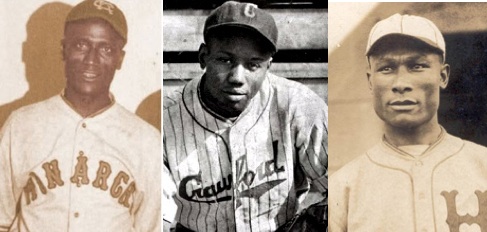Negro Leagues DB Update: 1930 Eastern Negro Leagues
January 25, 2015 by Gary Ashwill · Leave a Comment
We’ve added games between the 1930 eastern Negro league teams to the Seamheads Negro Leagues Database . It was an astonishing year in black baseball history, a year that saw the first Negro league games played at night, the first Negro league games played in Yankee Stadium, and the sudden emergence of one of the greatest talents in baseball history.
There was no eastern league in 1930, the American Negro League having disbanded after a single season—but the major eastern teams continued to play each other, leaving a decent number of games to compile. Ed Bolden, co-founder of the old Eastern Colored League, had lost control of the Hilldale Club to team official (and scorekeeper ) Lloyd Thompson, and many of the team’s best players fled. Biz Mackey (.444/,496/.704) was the biggest star who stayed, although he was pressed into service at shortstop instead of his best position, catcher. The talent just wasn’t there for Hilldale, which won only 7 games against east coast black professionals while losing 28.
Another longtime owner, Alejandro Pompezof the eastern Cuban Stars, dropped out of baseball entirely in 1930. His business partner, the somewhat notorious promoter Nat Strong, worked with veteran shortstop and Cubans captain Pelayo Chacón to bring a Cuban team to the New York area. This one was called the Stars of Cuba (recalling the name of a 1910 team ), and it was mostly noteworthy for bringing Martín Dihigo back to the Cuban fold (he had spent the previous two seasons with the Homestead Grays and Hilldale).
A player identified in press accounts as “Pelayo Chacón, Jr.” appeared briefly for the Stars in 1930, marking the first time I’ve seen that a father and son appeared in the same lineup for a Negro league team. ( Willie Wells, Jr. , would play alongside his father for the Memphis Red Sox in 1944.) We’ve been so far unable to identify him, except to note that he is clearly NOT this Pelayo Chacón, Jr. , who was born in Venezuela in 1933, and was the brother of Elio Chacón .
The collapse of the ANL meant that the eastern clubs were free to raid the western NNL teams for players. The Baltimore Black Sox were especially enthusiastic about this option, grabbing Satchel Paige from Birmingham and Mule Suttles from St. Louis. Both performed well (Paige went 3-1, Suttles hit .370 with 4 homers in 13 games), but the lack of a settled league cut into attendance and thus the team’s revenue, and the Black Sox couldn’t afford to keep their pricey acquisitions past mid-June.
Like the Black Sox, the New York Lincoln Giants landed a big NNL star—the Detroit Stars’ eccentric slugger Turkey Stearnes , the man who talked to his bats, flapped his arms while he ran, and specialized in lofting home runs over the close right field fence at Detroit’s Mack Park . Stearnes flourished (.425, 6 home runs in 19 games) in the Lincolns’ equally eccentric home park, the Catholic Protectory Oval , with its 150-foot foul lines. But like Suttles and Paige, by mid-June Stearnes had jumped back to Detroit.
Even not counting Stearnes, the Lincolns boasted of some of the east’s top perfomers, including John Beckwith (.486/.537/.905), Charlie “Chino” Smith (.406/.526/.700), and Bill Holland (13-3, 3.98). On July 5 they met the Black Sox in the first Negro league game ever staged in Yankee Stadium. The doubleheader that day attracted a crowd of 20,000, said to be the largest ever to view games between black teams to that date. The games were so successful that when the Lincolns met the Homestead Grays in an informal championship series in September, two more doubleheaders were held in the House That Ruth Built.
The Grays featured an 18-year-old catcher from the Pittsburgh sandlots named Joshua Gibson , who had been drafted into service when the Grays’ veteran backstop Buck Ewing broke his finger during a game. In the Grays-Lincolns series Gibson announced his arrival as a superstar, hitting .361 with four home runs ( one of them legendary ) as the Grays won, 6 games to 4. Meanwhile Chino Smith suffered an injury that was later (probably wrongly) blamed for his premature death in 1932.
An important note on the 1930 stats we’ve added: they do not include the 1930 Negro National League, and they do not include games between the eastern teams and the NNL teams. Of the teams currently posted, this mainly affects the Homestead Grays, who played the NNL extensively, especially the Kansas City Monarchs. (So Cyclone Joe Williams ’s famous 12-inning, 27-strikeout, 1 to 0 victory over Chet Brewer and the Monarchs is not yet in the DB.)
In addition to 1930, we have added games for 1896, 1897, 1898, and 1901—unfortunately, there were few black professional teams active during that era, and they didn’t play each other very often. Also, we have new games for 1912, 1914, 1915, 1917, 1918, 1919, 1920, 1926, 1934, 1935, and 1936. Many, many thanks to Todd Peterson, Paul Healey, and Scott Simkusfor their considerable help in collecting box scores.
Next up for the DB: 1931 eastern Negro leagues, 1924/25 Cuban League, 1932 East-West League, and more.


